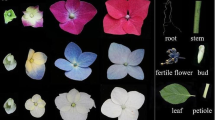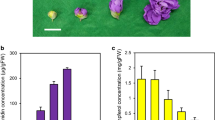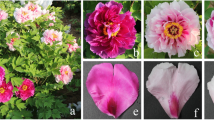Abstract
Flower color is one of the most important ornamental traits of flowering plants, and it has a major influence on the ornamental and economic value of flowers. The inflorescences of hydrangea are richly colored, and the plants with blue flowers are one of the most favorite types of hydrangeas. In this study, we identified the transcription factor HymMYB2 that is highly expressed in the sterile flowers of blue hydrangea cultivars. The open reading frame of the HymMYB2 was obtained by gene cloning, with a length of 939 bp that encodes 312 amino acids. HymMYB2 has R2 and R3 conserved domains, belongs to the R2R3-MYB family, and has the highest level of homology with the MYB2 of kiwifruit. The results of qPCR analysis showed that the HymMYB2 is expressed in all tissues and organs of hydrangea, and it is expressed at higher levels in blue tissues and organs. A correlation analysis showed that the level of expression of the HmMYB2 significantly correlated with the total anthocyanin content in the sterile flowers of the blue H. macrophylla 'Forever Summer' at the P < 0.01 level, but there was no correlation between the total anthocyanin content in sterile flowers of red and white hydrangea cultivars. The expression of HymMYB2 in the sterile flowers of blue H. macrophylla 'Forever Summer' correlated with the expression of C3′5′H (flavonoid 3′,5′-hydroxylase), DFR (flavanone 4-reductase) and ANS (anthocyanidin synthase) at the P < 0.01 level and the expression of F3H (naringenin 3-dioxygenase) and BZ1 (anthocyanidin 3-o-glucosyltransferase) at the P < 0.05 level. The transcription factor HymMYB2 may regulate blue flower color formation by affecting the levels of C3′5′H, DFR and ANS. In this study, we discovered that the transcription factor HymMYB2 has a positive regulatory effect on the formation of blue hydrangea flowers. The results provide a basis for the formation and breeding of blue hydrangea flowers.









Similar content being viewed by others
References
Abe H, Yamaguchi-Shinozaki K, Urao T, Iwasaki T, Hosokawa D, Shinozaki K (1997) Role of arabidopsis MYC and MYB homologs in drought and abscisic acid-regulated gene expression. Plant Cell 9:1859–1868. https://doi.org/10.1105/tpc.9.10.1859
Akagi T, Ikegami A, Yonemori K (2010) DkMyb2 wound-induced transcription factor of persimmon (Diospyros kaki Thunb.), contributes to proanthocyanidin regulation. Planta 232:1045–1059. https://doi.org/10.1007/s00425-010-1241-7
Albert NW, Lewis DH, Zhang H, Irving LJ, Jameson PE, Davies KM (2009) Light-induced vegetative anthocyanin pigmentation in Petunia. J Exp Bot 60:2191–2202. https://doi.org/10.1093/jxb/erp097
Albert NW, Lewis DH, Zhang H, Schwinn KE, Jameson PE, Davies KM (2011) Members of an R2R3-MYB transcription factor family in Petunia are developmentally and environmentally regulated to control complex floral and vegetative pigmentation patterning. Plant J 65:771–784. https://doi.org/10.1111/j.1365-313X.2010.04465.x
Bailey DA (1989) Hydrangea production. Growers Handbook, Timber Press
Chen HX, Guan QL, Li LQ (2008) MYB2 transcription factors of plant. Plant Physiol Commun 44:1134–1138. https://doi.org/10.13592/j.cnki.ppj.2008.05.026
Chen D, Li M, Peng J, Tian Y, Cao S (2020) Association between HmDFR gene expression and flower color of Hydrangea macrophylla. Plant Physiol J 56:1641–1649. https://doi.org/10.13592/j.cnki.ppj.2019.0454
Diao C, Hu B, Han Y, Zhang Y, Gao F, Jiugang W (2017) Effect of Al3+ on sepal color of different species of Occidentals. Shanghai Veg. https://doi.org/10.3969/j.issn.1002-1469.2017.04.040
Dirr MA (2005) Hydrangeas for American gardens. Timber Press, Port land
Eid GM (2015) Effect of aluminum sulfate on the chlorophyll a, chlorophyll b, carotenoids and anthocyanin content in some cultivars of hydrangea (Hydrangea macrophylla). J Aquat Plant Manage. https://doi.org/10.5376/ijh.2015.05.0009
Gelderen DMV (2004) Encyclopedia of hydrangeas. Timber Press
Goicoechea M, Lacombe E, Legay S, Mihaljevic S, Grima-Pettenati J (2005) EgMYB2, a new transcriptional activator from Eucalyptus xylem, regulates secondary cell wall formation and lignin biosynthesis. Plant J 43:553–567. https://doi.org/10.1111/j.1365-313X.2005.02480.x
Gong ZX, He Y, Yang J, Song Y, Ye ZX, Zhu ZJ (2017) Mechanism of exogenous Al2(SO4)3 on regulating the anthocyanin concentration in Hydrangea macrophylla petal. Plant Nutr Fertil Sci 23:821–826. https://doi.org/10.11674/zwyf.16407
Heisdorffer AM (2012) Hydrangeas with a past and a future. Kentucky
Hoeren FU, Dolferus R, Wu Y, Peacock WJ, Dennis ES (1998) Evidence for a role for AtMYB2 in the induction of the arabidopsis alcohol dehydrogenase gene (ADH1) by low oxygen. Genetics 149:479–490
Hsu CC, Chen YY, Tsai WC, Chen WH, Chen HH (2015) Three R2R3-MYB transcription factors regulate distinct floral pigmentation patterning in Phalaenopsis spp. Plant Physiol 168:175-U910. https://doi.org/10.1104/pp.114.254599
Ito T, Oyama K, Yoshida K (2018) Direct observation of hydrangea blue-complex composed of 3-o-glucosyldelphinidin, Al3+ and 5-o-acylquinic acid by esi-mass spectrometry. Molecules. https://doi.org/10.3390/molecules23061424
Ito T, Aoki D, Fukushima K, Yoshida K (2019) Direct mapping of hydrangea blue-complex in sepal tissues of Hydrangea macrophylla. Sci Rep. https://doi.org/10.1038/s41598-019-41968-7
Katiyar A, Smita S, Lenka SK, Rajwanshi R, Chinnusamy V, Bansal KC (2012) Genome-wide classification and expression analysis of MYB transcription factor families in rice and Arabidopsis. BMC Genomics. https://doi.org/10.1186/1471-2164-13-544
Kobayashi S, Ishimaru M, Hiraoka K, Honda C (2002) Myb-related genes of the Kyoho grape (Vitis labruscana) regulate anthocyanin biosynthesis. Planta 215:924–933
Kodama M, Tanabe Y, Nakayama M (2016) Analyses of coloration-related components in hydrangea sepals causing color variability according to soil conditions. Hortic J 85:372–379. https://doi.org/10.2503/hortj.MI-131
Kui L, Bolitho K, Grafton K, Kortstee A, Karunairetnam S, McGhie TK, Espley RV, Hellens RP, Allan AC (2010) An R2R3 MYB transcription factor associated with regulation of the anthocyanin biosynthetic pathway in Rosaceae. BMC Plant Biol. https://doi.org/10.1186/1471-2229-10-50
Li Z, Liu Y, Yang H, Liu N (2015) The identification of a MYB transcription factor and analysis of its expression in grape hyacinths (Muscari botryoides). J Northwest Forest Univ 30:15–21. https://doi.org/10.3969/j.issn.1001-7461.2015.02.03
Li X, Siddique F, Silva GTM, Quina FH, Lischka H, Aquino AJA (2019) Quantum chemical evidence for the origin of the red/blue colors of Hydrangea macrophylla sepals. New J Chem 43:7532–7540. https://doi.org/10.1039/c9nj00237e
Liu X, Xiang L, Yin X, Grierson D, Li F, Chen K (2015) The identification of a MYB transcription factor controlling anthocyanin biosynthesis regulation in Chrysanthemum flowers. Sci Hortic 194:278–285. https://doi.org/10.1016/j.scienta.2015.08.018
Livak KJ, Schmittgen TD (2001) Analysis of relative gene expression data using real time quantitative PCR and the 2-△△ct method. Methods 25:402–408. https://doi.org/10.1006/meth.2001.1262
McClintock EM (1957) A monograph of the genus Hydrangea. Proc Calif Acad 29:147–256
Nakatsuka A, Yamagishi M, Nakano M, Tasaki K, Kobayashi N (2009) Light-induced expression of basic helix-loop-helix genes involved in anthocyanin biosynthesis in flowers and leaves of Asiatic hybrid lily. Sci Hortic 121:84–91. https://doi.org/10.1016/j.scienta.2009.01.008
Nguyen NH, Lee H (2016) MYB-related transcription factors function as regulators of the circadian clock and anthocyanin biosynthesis in Arabidopsis. Plant Signal Behav. https://doi.org/10.1080/15592324.2016.1139278
Quattrocchio F, Wing JF, Leppen HTC, Mol JNM, Koes RE (1993) Regulatory genes controlling anthocyanin pigmentation are functionally conserved among - plant species and have distinct sets of target genes. Plant Cell 5:1497–1512. https://doi.org/10.1105/tpc.5.11.1497
Shimizu K, Ohnishi N, Morikawa N, Ishigami A, Otake S, Rabah IO, Sakata Y, Hashimoto F (2011) A 94-bp deletion of anthocyanidin synthase gene in acyanic flower lines of lisianthus (Eustoma grandiflorum (raf.) Shinn). J Japan Soc Hortic Sci 80:434–442. https://doi.org/10.2503/jjshs1.80.434
Spelt C, Quattrocchio F, Mol JNM, Koes R (2000) Anthocyanin1 of petunia encodes a basic helix-loop-helix protein that directly activates transcription of structural anthocyanin genes. Plant Cell 12:1619–1631. https://doi.org/10.2307/3871178
Sun J, Liu L, Zhao D (2018) Study on genetic transformation of tobacco with anthocyanin synthetic transcription factor Vlmyb2. J Mount Agric Biol. https://doi.org/10.15958/j.cnki.sdnyswxb.2018.01.002
Tanaka Y, Brugliera F (2013) Flower colour and cytochromes P450. Philos Trans R Soc B-Biol Sci. https://doi.org/10.1098/rstb.2012.0432
Tanaka Y, Sasaki N, Ohmiya A (2008) Biosynthesis of plant pigments: anthocyanins, betalains and carotenoids. Plant J Cell Molecul Biol 54:733–749. https://doi.org/10.1111/j.1365-313X.2008.03447.x
Wang S, Wang JW, Yu N, Li CH, Luo B, Gou JY, Wang LJ, Chen XY (2004) Control of plant trichome development by a cotton fiber MYB gene. Plant Cell 16:2323–2334. https://doi.org/10.1105/tpc.104.024844
Xue C, Han J, Peng J, Yang Y, Xiao H, Huang S, Dong X, Cao F (2019) Cloning and expression analysis of HmF3H gene related to flower color of Hydrangea Macrophylla. Mol Plant Breed. https://doi.org/10.13271/j.mpb.019.000059
Yamagishi M (2016) A novel R2R3-MYB transcription factor regulates light-mediated floral and vegetative anthocyanin pigmentation patterns in Lilium regale. Mol Breed. https://doi.org/10.1007/s11032-015-0426-y
Yamagishi M, Shimoyamada Y, Nakatsuka T, Masuda K (2010) Two R2R3-MYB genes, homologs of petunia AN2, regulate anthocyanin biosyntheses in flower tepals, tepal spots and leaves of Asiatic hybrid lily. Plant Cell Physiol 51:463–474. https://doi.org/10.1093/pcp/pcq011
Yamagishi M, Yoshida Y, Nakayama M (2012) The transcription factor LhMYB12 determines anthocyanin pigmentation in the tepals of Asiatic hybrid lilies (Lilium spp.) and regulates pigment quantity. Mol Breed 30:913–925. https://doi.org/10.1007/s11032-011-9675-6
Yamagishi M, Toda S, Tasaki K (2014) The novel allele of the LhMYB12 gene is involved in splatter-type spot formation on the flower tepals of Asiatic hybrid lilies (Lilium spp.). New Phytol 201:1009–1020. https://doi.org/10.1111/nph.12572
Zhang Y, Cao G, Qu LJ, Gu H (2009) Characterization of Arabidopsis MYB transcription factor gene AtMYB17 and its possible regulation by LEAFY and AGL15. J Genet Genomics 36:99–107. https://doi.org/10.1016/s1673-8527(08)60096-x
Zhao D, Tao J (2015) Recent advances on the development and regulation of flower color in ornamental plants. Front Plant Sci 6:261. https://doi.org/10.3389/fpls.2015.00261
Zhao C, Lv L, Zhao D (2012a) Studies on tomato transformation with VlmybA2 regulator gene. Genom Appl Biol 31:270–275. https://doi.org/10.3969/gab.031.000270
Zhao D, Tao J, Han C, Ge J (2012b) Flower color diversity revealed by differential expression of flavonoid biosynthetic genes and flavonoid accumulation in herbaceous peony (Paeonia lactiflora Pall.). Mol Biol Rep 39:11263–11275. https://doi.org/10.1007/s11033-012-2036-7
Zhu L, Shan H, Chen SM, Jiang JF, Gu CS, Zhou GQ, Chen Y, Song AP, Chen FD (2013) The heterologous expression of the chrysanthemum R2R3-MYB transcription factor CmMYB1 alters lignin composition and represses flavonoid synthesis in Arabidopsis thaliana. PLoS ONE. https://doi.org/10.1371/journal.pone.0065680
Acknowledgements
This research was supported by the Hunan Provincial Department of Education Outstanding Youth Project (18B176), the 13th Five-Year National Key R & D Program Project (2016YFD0600102), the Hunan Key R & D Program Project (2016NK2143), the Hunan University Students Innovation and Entrepreneurship Training Project (S202010538068), and the Project of Hunan Provincial Key Laboratory of Crop Germplasm Innovation and Utilization (Grant No.19KFXM13).
Author information
Authors and Affiliations
Corresponding author
Additional information
Publisher's Note
Springer Nature remains neutral with regard to jurisdictional claims in published maps and institutional affiliations.
Rights and permissions
About this article
Cite this article
Peng, J., Xue, C., Dong, X. et al. Gene cloning and analysis of the pattern of expression of the transcription factor HymMYB2 related to blue flower formation in Hydrangea macrophylla. Euphytica 217, 115 (2021). https://doi.org/10.1007/s10681-021-02839-3
Received:
Accepted:
Published:
DOI: https://doi.org/10.1007/s10681-021-02839-3




